#seiichi suzuki
Photo
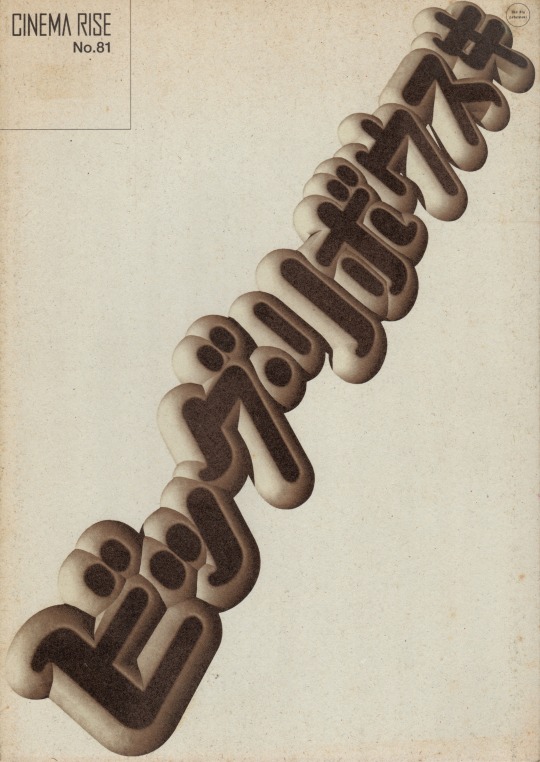
ビッグ・リボウスキ
アスミック・エース エンタテインメント株式会社
デザイン=鈴木成一デザイン室
監督・脚本=ジョエル・コーエン/製作・脚本=イーサン・コーエン/出演=ジェフ・ブリッジス、ジョン・グッドマン、スティーヴ・ブシェミ、ジュリアン・ムーア ほか
#the big lebowski#ビッグ・リボウスキ#seiichi suzuki#鈴木成一#鈴木成一デザイン室#joel coen#ジョエル・コーエン#ethan coen#イーサン・コーエン#jeff bridges#ジェフ・ブリッジス#john goodman#ジョン・グッドマン#steve buscemi#スティーヴ・ブシェミ#julianne moore#ジュリアン・ムーア#anamon#古本屋あなもん#あなもん#映画パンフレット#movie pamphlet#コーエン兄弟
163 notes
·
View notes
Text
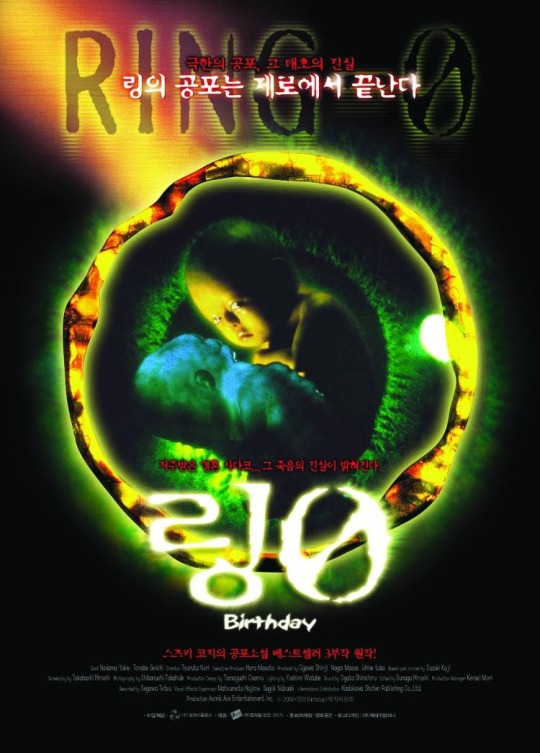

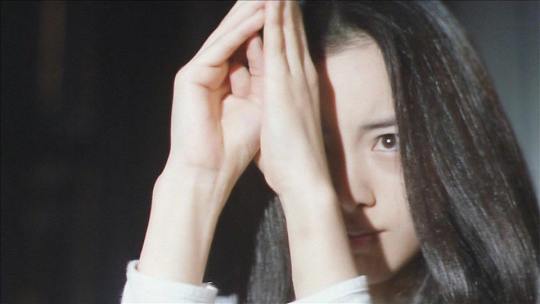
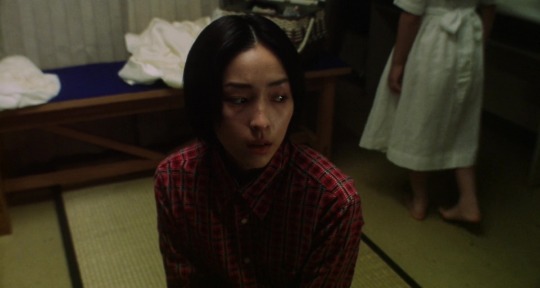
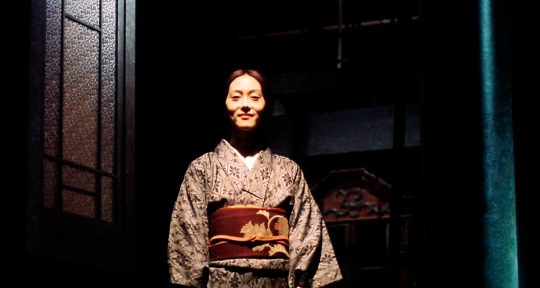
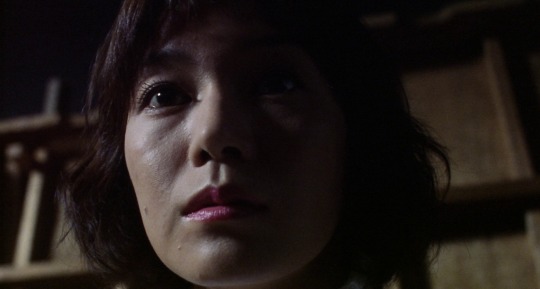




Ringu 0: Bâsudei (Ring 0: Birthday, 2000)
"Sadako, won't you tell me what it is that scares you?"
"There's someone here with me."
"Even now?"
"It's not someone I don't know. It's like a long, long time ago... but I only remember fragments... from when I was a child. And there's something there that terrifies me."
#Ringu 0: Bâsudei#Ring 0: Birthday#japanese cinema#horror imagery tw#Norio Tsuruta#hiroshi takahashi#Kôji Suzuki#yukie nakama#seiichi tanabe#kumiko asô#takeshi wakamatsu#kaoru okunuki#ryûshi mizukami#yasushi kimura#mami hashimoto#masako#norio murata#daisuke ban#2000#shin'ichirô ogata#in some ways the worst kind of horror fanservice; i don't need to know Sadako's back story‚ I'm not sure i even want to know#it robs the series of some of its ethereal mystery and i get why this isn't exactly beloved by fans of the first two films; but at the same#time i weirdly really enjoyed this. as impossible as it may seem for such a direct prequel‚ this almost works better if you try and forget#the Ring connections. the style is very different; this owes more to Carrie than it does Ringu‚ and Yukie Nakama's intense and brilliant#central performance belongs almost to another genre (something like teenbeat melodrama or tragic arthouse). the theatre setting is a big#thumbs up for me‚ and the way the scenes and themes of the play within the film begin to mirror the action of the larger plot is very#neatly done and satisfying. it falls more into line as a Ring sequel in the final 20 minutes which is fine but i had a lot more fun in#getting there than in the arrival. also notably less scary than the others; less a sense of palpable dread‚ more a feeling of unavoidable#tragedy‚ a mourning for the inevitable loss that's been set up as the only possible outcome here (but which i would have given anything to#change). i get why it frustrated some fans but i really dug this‚ has a kind of sad beauty to it
7 notes
·
View notes
Text
A LOOK BACK at KIETA HATSUKOI (or My Love Mix Up/Vanishing My First Love)
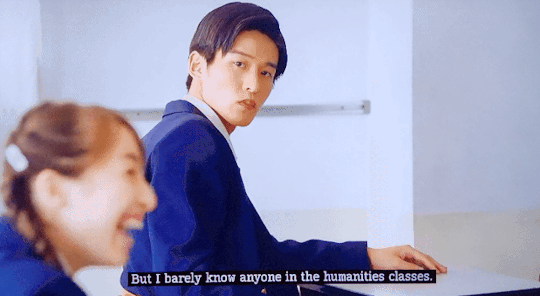
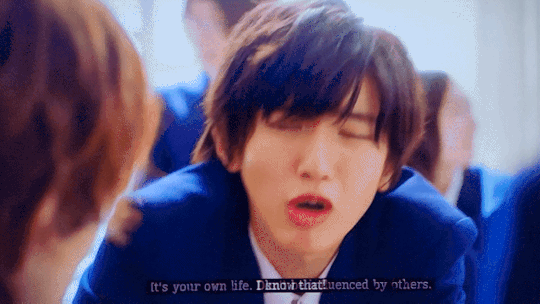
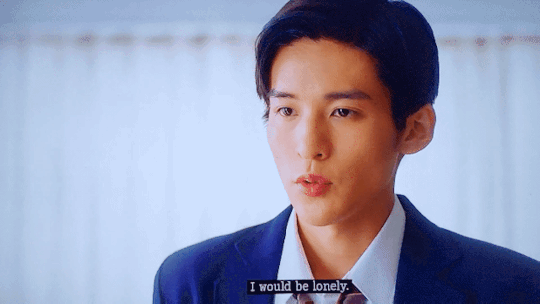






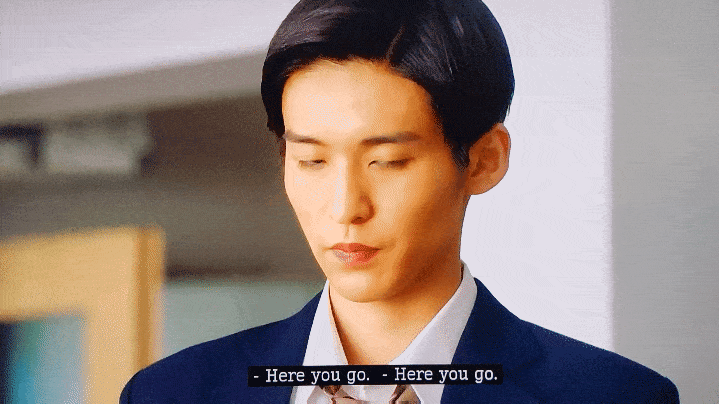
This Japanese BL was one of my favorites. A comedy with a mix of drama also known as DRAMEDY
The story of Aoki (SHUNSUKE MICHIEDA) who was in love with female class Hashimoto (FUKUMOTO RIKO) and she was in love with his best friend Aida (SUZUKI JIN) though Aoki thought she was into Ida (REN MEGURO) a male student that sat directly in front of Aoki.
And it all stemmed from Aoki borrowing Hashimoto's eraser. Which had IDA on it because the AIDA that was meant to be on it was worn away by use.
Then we have the homophobic training teacher (SHIRASU JIN) there to learn from Taniguchi (TANABE SEIICHI) who took and issue with Ida and Aoki's relationship...but he did learn a lesson and apologized.
This series has a Thai version upcoming. I love GEMINI & FOURTH but can they deliver an "AOKI" AND "IDA" worthy of the original?
@pose4photoml @lutawolf @bengiyo @absolutebl
#A LOOK BACK#KIETA HATSUKOI#MY LOVE MIX UP#VANISHING MY FIRST LOVE#AOKI AND IDA#HASHIMOTO AND AIDA#My GIFS#MYGIFSET#MY-GIF-EDIT#BL-BAM-BEYOND FAMILY OF BLOGS#WILL THE THAI VERSION STAND UP TO THE JAPANESE VERSION?#I LOVE GEMINI-FOURTH#BUT..
36 notes
·
View notes
Text

Not happy with the translation of this page but think i have it maybe 80 to 90% correct.
20th century NISSAN MOTORSPORTS
1958-2000
'60~
The infancy of domestic racing.
R381 and R382 win consecutive Japanese Grand Prix victories
The dawn of full-fledged motorsports in Japan
The origin of the visit dates back to the late 1950s, when a two-wheeled Asama Volcano race was held. As the 1960s entered, domestic motorcycle manufacturers began to win on the world GP stage, and Japanese industry became a reality on the world stage.
I proved it. The Suzuka Circuit was completed in the fall of 1962, and Japan's first full-scale automobile race, the 1st Japan Grand Prix, was held the following year in May 1963. Each automobile manufacturer, taking note of its promotional effects, soon formed a works team. Nissan selected powerful riders one after another, such as Kenjiro Tanaka, Kunimitsu Takahashi, Gen Kitano, Motoharu Kurosawa, Masahiro Hasemi, Kenji Tohira, Seiichi Suzuki, and Kazuyoshi Hoshino, and many of them went on to become main players in the domestic four-wheel racing world. It will reign for a long time.
Funabashi Circuit in 1965 and Fuji Speedway opens in 1966. Kanto and all over Japan
The racing fever is increasing. Just in time for Tokyo Motor Show.
The automobile industry was in a period of high growth before and after the pick-up.
It was a time when it made great strides as Japan's core industry.
Then, in 1966, Nissan and Prince merged, and Japan's first racing sports car “Prince R380”
will further evolve under Nissan.
In 1968, a large displacement engine with a unique huge wing was introduced.
The R381, with its powerful engine, and the R382 the following year defeated strong rivals to win the Japanese Grand Prix. And formula car races are held in Japan.
Fairlady/Skyline/Bluebird GT cars and Touring cars.
Many car races, as well as endurance races that included these races, were held.
Nissan also actively participated in overseas rallies.
At a time when the World Rally Championship did not yet exist,
Monte Carlo and Safari became the main battlegrounds.
The 1960s was the infancy of domestic racing.
It was a time of rapid evolution and growth. However, the issue of automobile exhaust gas became apparent in the 70s.
In early summer of 1969(?) , Nissan announced that it would be absent from the Japanese GP, and at that moment,
Domestic motor sports had only been growing until then.
The world was forced to seek a new direction.
2 notes
·
View notes
Text
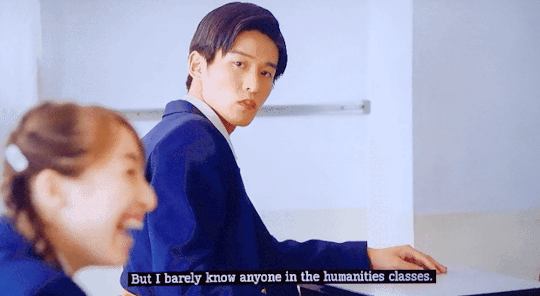








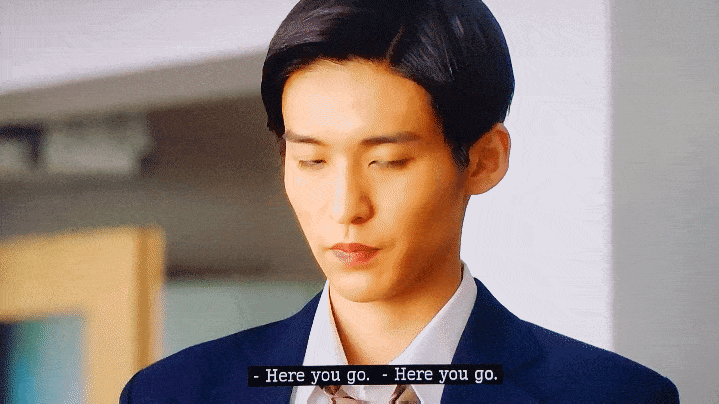
MADE IN JAPAN
REN MEGURO
MICHIEDA SHUNSUKE
SUZUKI JIN
FUKUMOTO RIKO
TANABE SEIICHI
&
SHIRASU JIN
#MADE IN JAPAN#From My Main Blog: BL-BAM-BEYOND#JAPANESE BL SERIES#ROMANTIC COMEDY#KIETA HATSUKOI#VANISHING MY FIRST LOVE#MY LOVE MIX UP#THE STORY OF IDA & AOKI#KOUSUKE & SOTA#My GIFS#MYGIFSET#MY-GIF-EDIT#BL-BAM-BEYOND FAMILY OF BLOGS
5 notes
·
View notes
Text
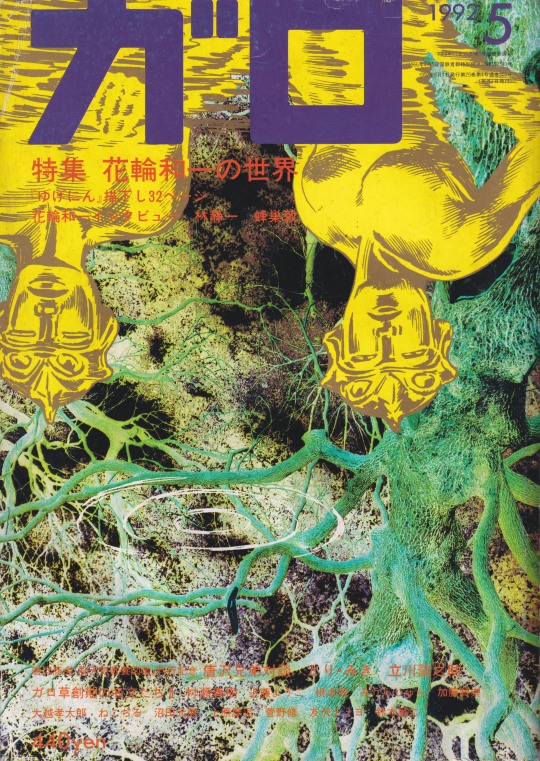
Garo 1992-05 has been scanned by Choolete and is uploading here.
Contains an interview with Kazuichi Hanawa.
1992-05 328 [表紙] ヒョウシ [Cover] Front cover
1992-05 328 [目次] モクジ [Table of Contents] Editor's Announcements
1992-05 328 [インタビュー/対談/座談会] インタビュータイダンザダンカイ [Interview / Dialogue / Roundtable] Novels and reading materials
1992-05 328 花輪和一 Kazuichi Hanawa ゆげにん ユゲニン Yugenin Manga works
1992-05 328 蜂巣敦 蜂巣敦 因果の破壊者、花輪和一 インガノデストロイヤーハナワカズイチ Kazuichi Hanawa, the destroyer of causality Novels and reading materials
1992-05 328 林静一 Seiichi Hayashi 黒っぽいコマ絵 クロッポイコマエ Blackish frame picture Manga works
1992-05 328 鈴木翁二 Oji Suzuki 少年存在学ノート ショウネンソンザイガクノート Boy Existence Notebook Manga works
1992-05 328 唐沢俊一/唐沢なをき 唐沢俊一/唐沢なをき 失われたギャグを求めて ウシナワレタギャグヲモトメテ In search of the lost gag Novels and reading materials
1992-05 328 唐沢俊一 唐沢俊一 脳天気教養図鑑拾遺 ノウテンキキョウヨウズカンシュウイ Collection of brain weather culture pictorial book Novels and reading materials
1992-05 328 唐沢なをき 唐沢なをき よくわかる小6理科 ヨクワカルショウ6リカ Easy-to-understand small 6 science Manga works
1992-05 328 立川談之助 立川談之助 怪人 唐沢俊一 カイジンカラサワシュンイチ Phantom Shunichi Karasawa Novels and reading materials
1992-05 328 鹿野景子 鹿野景子 唐沢兄弟の秘密 カラサワキョウダイノヒミツ The secret of the Karasawa brothers Manga works
1992-05 328 とり・みき とり・みき 戦友に愛をこめて センユウニアイヲコメテ With love for your comrades Novels and reading materials
1992-05 328 礒田ゆり子 礒田ゆり子 覗き ノゾキ Peep Manga works
1992-05 328 安彦麻理絵 安彦麻理絵 寝すごした朝 ネスゴシタアサ Morning spent sleeping Manga works
1992-05 328 泉晴紀 泉晴紀 うきーで一発 ウキーデイッパツ One shot at Uki Manga works
1992-05 328 上原摩泥 上原摩泥 NO NO NO 霊脳サイバネKID NONONOレイノウサイバネKID NO NO NO Rei Brain Cybernetics KID Manga works
1992-05 328 杉作J太郎 Jeitarô Sugisaku 宇宙縁談ゴリ・激突篇 ウチュウエンダンゴリゲキトツヘン Space Marriage Gori / Crash Hen Manga works
1992-05 328 杉作J太郎 Jeitarô Sugisaku ギャンブル新聞 ギャンブルシンブン Gambling newspaper Novels and reading materials
1992-05 328 友沢ミミヨ 友沢ミミヨ だーるまさんがころんだ ダールマサンガコロンダ Daruma-san fell Manga works
1992-05 328 沼田元氣 Genki Numata 憩写真帖 イコイシャシンチョウ Rest Photo Album Photographs and gravures
1992-05 328 Q.B.B. Q.B.B. オトナは37564 オトナハ37564 Adults are 37564 Manga works
1992-05 328 松井雪子 松井雪子 アパート夫人 アパートフジン Mrs. Apartment Manga works
1992-05 328 みうらじゅん Jun Miura アイデン&ティティ アイデン&ティティ Aiden & Titi Manga works
1992-05 328 ねこぢる ねこぢる ねこぢるうどん ネコヂルウドン Nekojiru Udon Manga works
1992-05 328 菅野修 Osamu Kanno 幻のゆくえ マボロシノユクエ Whereabouts of the illusion Manga works
1992-05 328 加藤賢崇 加藤賢崇 がんばれ!いぬちゃん ガンバレイヌチャン Good luck! Inu-chan Manga works
1992-05 328 三本義治 三本義治 淘太でドーダ トウタデドーダ Doda at Shouta Manga works
1992-05 328 近藤ようこ 近藤ようこ 妖霊星 ヨウレイセイ Youkai Star Manga works
1992-05 328 大越孝太郎 Kotaro Ogoshi 星にねがいを ホシニネガイヲ Give a wish to the stars Manga works
1992-05 328 大越孝太郎 Kotaro Ogoshi パノラマ大百貨店 パノラマダイヒャッカテン Panorama Department Store Novels and reading materials
1992-05 328 イタガキノブオ Itaga Kinobuo ヴァリアント ヴァリアント Variant Manga works
1992-05 328 中ザワヒデキ 中ザワヒデキ しーじー少女椿 シージーショウジョツバキ Shiji Shoujo Tsubaki Manga works
1992-05 328 三橋乙揶 Mihashi Otoko OM短報号外 OMタンポウゴウガイ OM Extra Special Feature Articles
1992-05 328 土橋とし子 土橋とし子 青空脳天満腹画報 アオゾラノウテンマンプクガホウ Blue Sky Brain Tenman Stomach Pictorial Novels and reading materials
1992-05 328 [特集] トクシュウ [Special feature] Special Feature Articles
1992-05 328 特殊漫画博覧会記念・根本敬・関西紀行(抄) 梵悩・悟り・宇宙、そしてコンビニエンス トクシュマンガハクランカイキネンネモトタカシカンサイキコウショウボンノウサトリウチュウソシテコンビニエンス Special Comic Exhibition Memorial, Takashi Nemoto, Noriyuki Kansai (Excerpt) Anxiety, Enlightenment, Space, and Convenience Special Feature Articles
1992-05 328 MEGARO MIX MEGAROMIX MEGARO MIX Novels and reading materials
1992-05 328 四方田犬彦 Inuhiko Yomota 犬も歩けば イヌモアルケバ If the dog walks too Novels and reading materials
1992-05 328 久住昌之 Masayuki Kusumi 出たとこ勝ぶ デタトコショウブ Win when it comes out Novels and reading materials
1992-05 328 高杉弾 Dan Takasugi 倶楽部イレギュラーズ クラブイレギュラーズ Club Irregulars Novels and reading materials
1992-05 328 松沢呉一 Kureichi Matsuzawa 飲尿自転車男業界漫遊記 インニョウジテンシャオトコギョウカイマンユウキ Urophagia Bicycle Man Industry Manyuuki Novels and reading materials
1992-05 328 上野昂志 Koshi Ueno 黄昏映画館 タソガレエイガカン Twilight cinema Novels and reading materials
1992-05 328 読者サロン ドクシャサロン Reader Salon Submission Page
43 notes
·
View notes
Text
One with the Cow


Garo 1983 August issue with cover art by King Terry/Landscape with Cows cover page
At no point in my reading journey would I have expected to read such a compelling story that intertwined identity and cows so seamlessly. And no, they're not separable. The two work hand in hand to open my eyes to such an expressive and unique style of storytelling.
The story in question is Kanno Osamu's "Ushi no iru Fuukei" (The Landscape with Cows) from Garo. There isn't too much info on Kanno that I personally could find, but he had debuted in Yagyo in 1973 and has published works in a few other magazines mainly in the 70s and 80s. Currently, he's serialising his "Meshia no Umi" (The Sea of the Messiah) series in AX, with the most recent issue at this current date (vol 154) including its 66th chapter. His style can be traced back to the dreamlike and surreal storytelling of gekiga greats like Hayashi Seiichi and Tsuge Yoshiharu. Those two mangaka are cited as his inspirations, but other mangaka that have styles along the same vein also include Abe Shinichi and Oji Suzuki (for those who are curious for more). With Garo, I've been exposed to a wide variety of amazing artists and stories, but "The Landscape with Cows" is one of the best one-shots I've read so far from this magazine.
Neurosis?
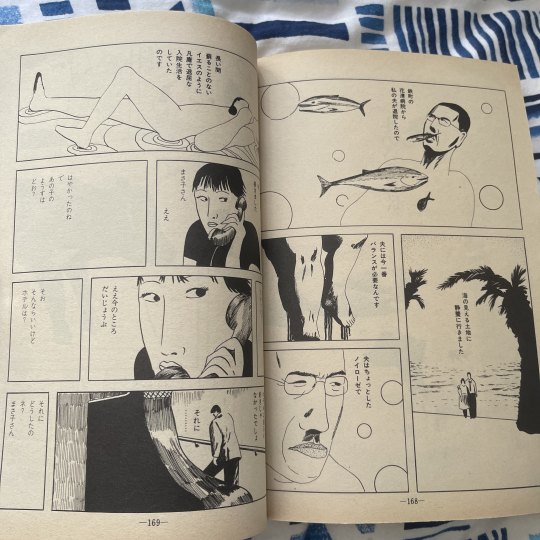

Our story begins with our narrator Masako calling her mother-in-law on the phone to update her on her son. Masako's husband had recently been discharged from the hospital for a case of neurosis after he had sent some concerning letters to his parents. They're currently staying at a hotel near a beach as he recovers, but something interesting about the location is its abundance of cows. Masako thinks that maybe it could be a tourist attraction, but also that they look visually off-putting to her.
"[The cows are] kind of grotesque aren't they."
She assures her mother-in-law over the phone that all is well with her husband. The mother is quite over-worried and anxious, an overly protective parent. We never get to see what the mother looks like, but it's quite clear that she's being a bit of a handful with her check-ups.
Right after the first four pages, Kanno shows a strange scene of the husband naked, bending over and making cow noises with 'horns' attached to his head.


"That time, when I looked into his eyes, I was speechless"
Masako recounts her experience seeing her husband in this strange position. She also reveals that she always knew her husband was gay and that his love for her was never true. In the background, a giant dinosaur looms, very reminiscent of Oji Suzuki's surreal gekiga style. I am incredibly in love with this characteristic seen in gekiga frequently: seemingly random placements of objects that make the story's atmosphere extremely mysterious and reflective.

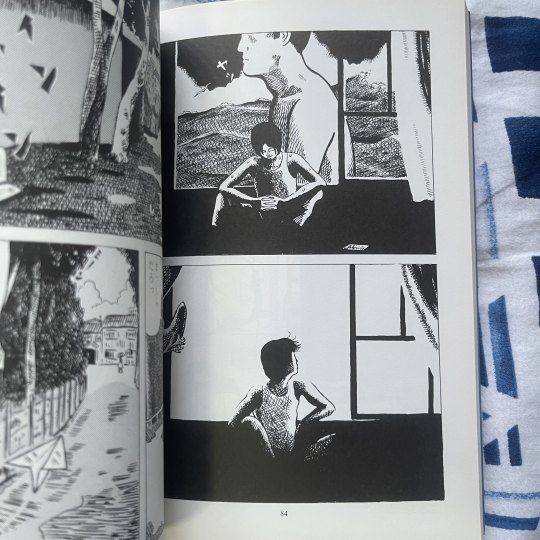
Various panels from Oji Suzuki's 'Motorbike Girl' tankobon
Cows Over Humans
Masako's mother-in-law continues to ask her to take care of her son, this time expressing that she's scared of him taking his own life. But Masako thinks to herself that it might be something different:
"I don't think he's thinking about killing himself. I think it's that he wants to be reborn as a cow after dying."
This line is such an interesting one to think about. Coupled with the ominous imagery, especially the panel with his head being that of a cow, you wonder about what it is about bovines that appeal to the husband. Or, maybe you're not supposed to know. The way that Kanno depicts the husband's obsession doesn't put it down and merely just treats it as just another way of thinking, another belief or worldview that anyone can have. It's especially made apparent when Masako starts reassuring her mother-in-law about the contents of her husband's letter:
"What he said about cows being better than people is wrong. Isn't that right, mum."

On this page, what follows Masako's line are panels of random people with words like famine, culture, disease, and pretty much any human concept/idea/issue that exists. These examples contradict what Masako is saying on the phone, and shows that her husband might be right in saying that cows are better than humans after all. His mum can be representative of those who can't understand the sensibilities of people with different worldviews or beliefs, which I think plays out quite well with Masako being in the middle of all this. Her relationship with both mother and son gives her a unique perspective, and hence narration, on her husband's 'neurosis'. She has to assure that everything is okay for the worried mother, but also has to internalise the thoughts she has about her husband's true situation.

"Cows don't fight. They aren't dishonest like humans are."
So what is wrong with wanting to be a cow? They don't fight, they aren't corrupt or start wars or anything like that. They are simple creatures devoid of any worries other than their survival. Masako's line about dishonesty is ironic considering how she'd lied to her mother-in-law over the call. What the quote says to me is that Masako is fed up with having to put on an appearance to her in-law. She has to lie and assure her that everything is okay, but all of that can be such a chore. Which comes back to the point that I believe Kanno could be conveying: what's wrong with wanting to be a cow? What's wrong with wanting to be free from human flaws?
This thought process I have with what Kanno could possibly be trying to say brings me back to Tsuge Yoshiharu's "The Incident at Nishibeta Village", which follows a village's hunt for a man who had 'escaped' the sanatorium. Though, when we do encounter the escapee, he doesn't seem as crazy or violent as the villagers make him out to be. That clash between the man and the rest of the villagers is quite similar to this situation with the husband and his mum. Is he as crazy or suicidal as she thinks he is? Doesn't seem like it from the way Kanno depicts him.

Tsuge Yoshiharu's "The Incident at Nishibeta Village" - taken from Tom Gill's article in the Asia-Pacific Journal
The way this story progresses points more and more towards the husband's desire being something that is normal. He may be judged on the outside by those who don't know him well, that being his mum in this case. But for those who do understand him, that being Masako, they can understand where he is coming from and why his desires aren't so outrageous. The husband's neurosis and the duality of how its perceived by others is such an interesting topic that really makes the cow imagery natural to the story.

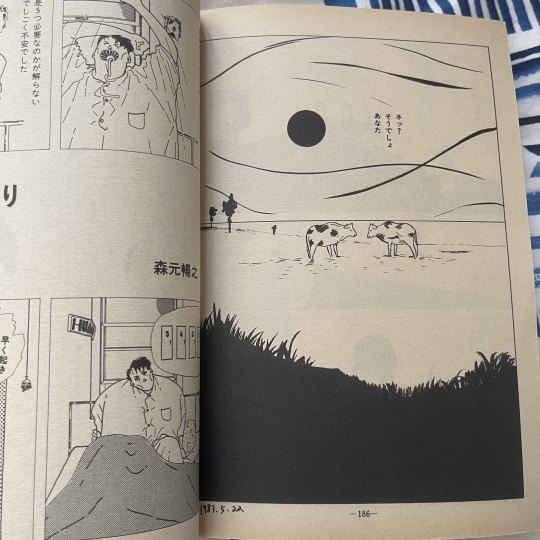
At the end of the story, Masako continues to voice her thoughts through the narration.
"If he wants to be a cow, then be a cow. That person will still always be my husband. Isn't that right, you?"
Here, this last section of dialogue is Masako expressing her views on her husband's situation. It's a confirmation that she doesn't view the desire as negatively as his mother. There could also be a hint of jealousy in her with how she has deal with the over-protective parent. Her husband doesn't have to worry about these trivial things. Living in bliss, no matter the form, is living in bliss. It doesn't matter if you want to be a cow or anything else. The husband is in a state of bliss that is impenetrable by human worries and concerns.
Final Thoughts
Kanno Osamu is a mangaka that I really want to read more from, but his tankobons are quite hard to find. "The Landscape with Cows" was my first exposure to him and reinforced what I love about gekiga. As I had mentioned before, other mangaka like Hayashi Seiichi, Oji Suzuki and Abe Shinichi all have similar styles in storytelling. They are mysterious in the way they depict characters and settings, oftentimes placing seemingly random panels and objects throughout their narratives. What draws me the most to their works is the atmosphere, one that I think is quite unique to Japanese artists and mangaka. One of my favourite books, "Almost Transparent Blue" by Ryu Murakami, also gives off the same tone as a lot of gekiga. Their stories are about people getting by, wanting to escape from the world to live in bliss, unconcerned about wars, careers, relationships and the future in general. With this story by Kanno, it pretty much says the same thing. What is wrong with wanting to be free? If you want to be a cow, so be it. It's a normal desire to have, no matter what form it may manifest in. Legendary short story in my opinion, one of my favourites from Garo.
Thanks for reading!
2 notes
·
View notes
Photo
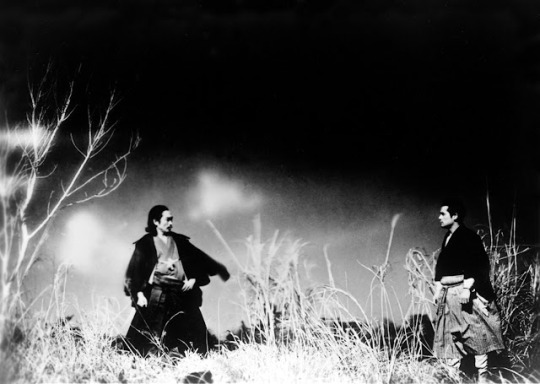
Ryunosuke Tsukigata and Susumu Fujita in Sanshiro Sugata (Akira Kurosawa, 1943)
Cast: Susumu Fujita, Denjiro Okochi, Yukiko Todoroki, Ryunosuke Tsukigata, Takashi Shimura, Ranko Hanai, Sugisaki Aoyama, Ichiro Sugai, Yoshio Kusugi, Kokuten Kodo. Screenplay: Akira Kurosawa, based on a novel by Tsuneo Tomita. Cinematography: Akira Mimura. Art direction: Masao Tozuka. Film editing: Toshio Goto, Akira Kurosawa. Music: Seiichi Suzuki.
You know the plot: A talented, cocky young newcomer takes on the old pros and gets his ass kicked, but he learns self-discipline and becomes a winner. You've seen it played out with young doctors, lawyers, musicians -- it's even the plot of Wagner's Die Meistersinger -- and others challenging the established traditions. But mostly it's the plot for what seems to be about half of the sports movies ever made, including Akira Kurosawa's first feature, Sanshiro Sugata. It's also a film about the conflict between rival martial arts disciplines, jujitsu and judo, but fortunately you don't need to know much about the nature of the conflict to follow the film. From what I gather from reading the Wikipedia entry on judo, the founder of that discipline, Jigoro Kano, wanted to give jujitsu a philosophical underpinning that would put an emphasis on self-improvement for the betterment of society, and he called it judo because "do," like the Chinese "tao," means road or path. Kano's renaming was meant to shift the emphasis from physical skill to spiritual purpose. In Kurosawa's film, young Sanshiro (Susumu Fujita) comes to town wanting to find someone to teach him jujitsu, and signs up with a teacher who accepts a challenge from the judo master Shogoro Yano (Denjiro Okochi) -- the name is an obvious twist on "Jigoro Kano." Sanshiro watches as not only the teacher but all of the other members of his dojo are defeated -- in fact, tossed into the river -- by Yano. Whereupon Sanshiro becomes a follower of Yano's, but has to undergo some defeats and a cold night spent in a muddy pond before he gets the idea of what judo is all about. The film was not a big hit with the wartime Japanese censors, who wanted more aggression and less philosophy in their movies, so 17 minutes were cut from it, never to be seen again. In the currently available print, the missing material is summarized on title cards, but what's left is more than enough to show that Kurosawa arrived on the scene as a full-blown master director. His camera direction is superb, and he knows how to tell a story visually. For example, when Sanshiro joins up with Yano, he kicks off his geta, his wooden clogs, so he can pull Yano's rickshaw more efficiently. Kurosawa cuts to a passage-of-time montage in which we see one of the abandoned geta lying in the road, then in a mud puddle, covered with snow, then tossed aside as spring comes. The film's crucial scene is a showdown between Sanshiro and his jujitsu rival, Higaki (Ryunosuke Tsukigata), in a field of tall grasses, swept by wind with rushing clouds overhead; it's a spectacular effect, even if the battle turns out to be a bit anticlimactic. However much the censors may have disliked it, audiences were enthusiastic enough that Kurosawa was persuaded to make a sequel.
Sanshiro Sugata, Part Two (Akira Kurosawa, 1945)
Cast: Susumu Fujita, Denjiro Okochi, Ryunosuke Tsukigata, Akitake Kono, Yukiko Todoroki, Soji Kiyokawa, Masayuki Mori, Kokuten Kodo, Osman Yusuf, Roy James. Screenplay: Akira Kurosawa, based on a novel by Tsuneo Tomita. Cinematography: Takeo Ito. Production design: Kazuo Kubo. Film editing: Akira Kurosawa. Music: Seiichi Suzuki.
Patched together from what aging film stock could be gathered during the end-of-war shortages in Japan, and interrupted during its filming by bombing raids, Sanshiro Sugata, Part Two was a labor imposed on the writer-director by the studio, Toho, and Kurosawa's lack of enthusiasm for the project shows. The story is routine: Sanshiro has helped judo triumph over jujitsu as the primary Japanese martial art, but he has gone into retreat for several years, honing his spirituality. But one day he comes across an American sailor (Osman Yusuf) beating up a rickshaw driver -- a job he once took on himself -- and thrashes the bully. This brings him to the attention of a promoter who wants to stage a fight between the judo master and an American boxer named William Lister (Roy James). Eventually, after another fighter is beaten to a pulp by Lister, Sanshiro gives in and thrashes Lister, giving the prize money to the fighter who had been beaten. Meanwhile, his old opponent, Gennosuke Higaki (Ryunosuke Tsukigata), whom he defeated at the end of the first film, warns him that his brothers, Tesshin (also Tsukigata) and Genzaburo Higaki (Akitake Kono), are out to revenge themselves for Gennosuke's defeat. They are masters of karate, which originated on Okinawa and was just making its way into mainland Japan at the time when the film is set, the late 19th century. Gennosuke gives Sanshiro a scroll depicting the basics of karate to help him in the eventual fight with the brothers. Naturally, the film concludes with a fight between Sanshiro and Tesshin -- the other brother is recovering from an epileptic seizure -- that takes place in the snow, an echo of the fight in the original film with Gennosuke in a windswept field of tall grasses. This battle is the only part of the film that shows much commitment on the part of Kurosawa, who insisted that the principals fight barefoot in the snow, not without many complaints from the actors. Unfortunately, the poor film stock, unable to provide shades of gray, turns much of this fight into a battle of silhouetted figures. Much has been made of the propaganda in the film, particularly the portrayal of the hapless American sailor and boxer, but Kurosawa, no lover of the imperial regime, manages to shift the film's emphasis to the fearsomely wild Higaki brothers.
3 notes
·
View notes
Text
Έτος Πολιτισμού-Τουρισμού Ελλάδος - Ιαπωνίας 2024 | Συνάντηση Κεφαλογιάννη με τον Ιάπωνα πρέσβη
Την Yπουργό Τουρισμού, κυρία Όλγα Κεφαλογιάννη επισκέφθηκε σήμερα ο Ιάπωνας Πρέσβης, κ. Nakayama Yasunori, συνοδευόμενος από το Γραμματέα Α’ της Πρεσβείας, κ. Seiichi Suzuki.
Η κα Κεφαλογιάννη αναφέρθηκε στην ενίσχυση της τουριστικής συνεργασίας Ελλάδας-Ιαπωνίας στο πλαίσιο της νέας φάσης ανάπτυξης των διμερών σχέσεων που επισφραγίστηκε κατά http://dlvr.it/SvNzbK
0 notes
Text
Japanese shares rise as tech stocks jump
Japanese shares rise as tech stocks jump
By 0215 GMT, the Nikkei share average .N225 Up 0.9% to 28,128.04 and broad topics .TOPX It advanced 1.03% to 1,964.02.
“Wall Street fell overnight but their losses were limited, based on sentiment for the Japanese market,” said Seiichi Suzuki, chief equity market analyst at Tokai Tokyo Research Institute.
“US futures gains are another positive factor.”
U.S. stocks closed lower on Monday, even…
View On WordPress
0 notes
Text
i hate gay people.txt
read it on the AO3 at https://ift.tt/rohsu9H
by wiltshires
the story of legend only heard of in the gag discord.
as the title suggests, they hate gay people. (you're welcome annie....)
Words: 754, Chapters: 1/?, Language: English
Fandoms: Dangan Ronpa - All Media Types, Danganronpa: Gods at Gunpoint
Rating: Teen And Up Audiences
Warnings: No Archive Warnings Apply
Characters: Mitsue Kasai, Seiichi Sato, Akira Yanagi, Emi Ito, Hanae Masaki, Kimiko Usui, Keiko Ishii, Natsuka Oomori, Nami Shizuku, Shizuka Suzuki, Momoko Norimaki, Reiji Matsumoto, Ikugorou Katsuki, Amehiko Narasaki, Hitomu Kawajiri, Itsuki Nakatsuka
Additional Tags: chatfic, Chatting & Messaging, do i gotta tag all the characters, I mean, I guess I do, eventually yanasatokasa will be real, i prommy ok?
read it on the AO3 at https://ift.tt/rohsu9H
0 notes
Text
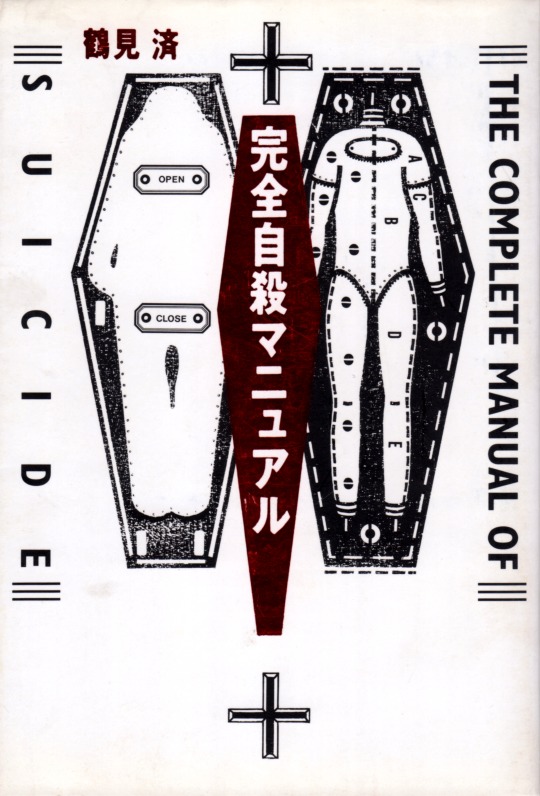
完全自殺マニュアル 鶴見済
太田出版
Illustration=サダヒロカズノリ、Book Design=鈴木成一デザイン室
#完全自殺マニュアル#wataru tsurumi#鶴見済#seiichi suzuki#鈴木成一#鈴木成一デザイン室#kazunori sadahiro#SADAHIRO Kazunori#サダヒロカズノリ#anamon#古本屋あなもん#あなもん#book cover
46 notes
·
View notes
Text
Kieta Hatsukoi Ep. 5 (Sub. Esp)

DESCARGAR O VER ONLINE EN
Crazy Asian Love Fansub | Snow Subs Livejournal (friends only)
#kieta hatsukoi#kiekoi#jdrama#meguro ren#michieda shunsuke#fukumoto riko#suzuki jin#tanabe seiichi#drama#dorama#proyectos activos#sub. español
34 notes
·
View notes
Text

Friends going to the arcade! Featuring Kotei ( @sketchartist444 ), Kouzai, Suzuki ( @standard-fiendart ) and Seiichi ( @juchumice )!
56 notes
·
View notes
Photo

d1sk_t 楽日!四天王と!!!いざ決戦!
28 notes
·
View notes
Text
TV- Mr. Hiiragi’s Homeroom

10 days before graduation, Hiiragi, a high school art teacher, takes his class hostage. Having set up bombs and cameras all over the school, he broadcasts to the world his one condition for letting the students go: find the people responsible for the death of Reina Kageyama, a classmate of the students he took hostage. He challenges the class to figure out the mystery themselves, lest they never get to attend their own graduation ceremony. It warms my heart to see Masaki Suda play a teacher when my first drama with him was when he played the sadistic bully of 35-Year-Old High School Student (in my headcanon this is the same character). Of course you’re set for an amazing drama when Suda is the lead, a cast of talented up-and-coming performers, and a plot-twist rich story you’ll never see coming. Like all dramas centered around a teacher changing the lives of their class, this will cause all sorts of feel, but above all you’ll wish you had a teacher like Hiiragi growing up.
Spotlighting: Masaki Suda, Mei Nagano, Moka Kamishiraishi, Ryoma Katayose, Mio Imada, Rina Kawaei, Jin Suzuki, Nana Mori, Haruka Fukuhara, Mayu Hotta, Kaito Mifune, Yu Kamio, Seiichi Tanabe, Akane Hotta, Jiei Wakabayashi, Fuju Kamio, Ayumu Mochizuki, Riku Hagiwara, Miu Tomita,
#suda masaki#nagano mei#kamishiraishi moka#katayose ryota#imada mio#kawaei rina#suzuki jin#mori nana#fukuhara haruka#hotta mayu#mifune kaito#kamio yu#tanabe seiichi#hotta akane#wakabayashi jiei#kamio fuju#mochizuki ayumu#hagiwara riku#tomita miu#drama#friendship#suspense
11 notes
·
View notes